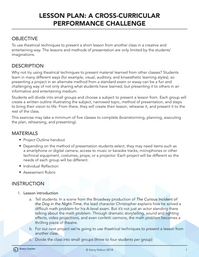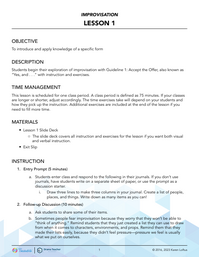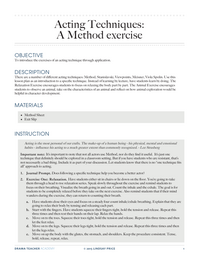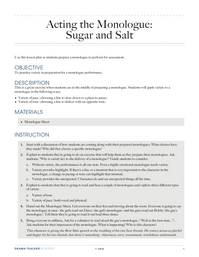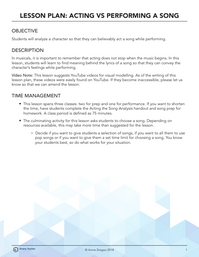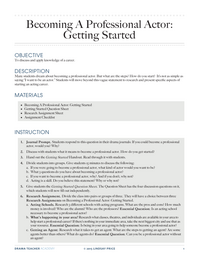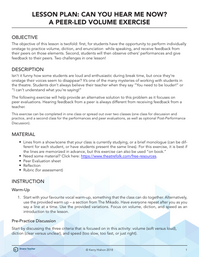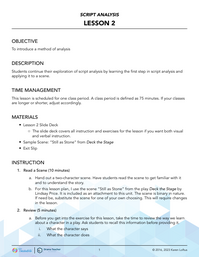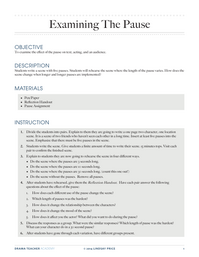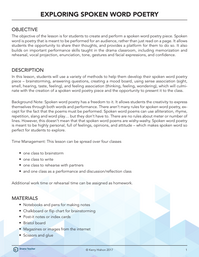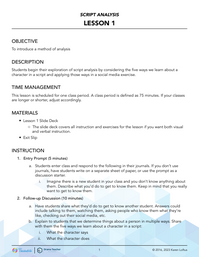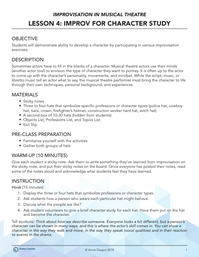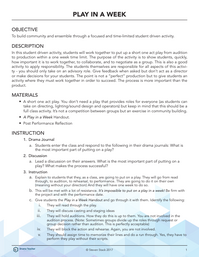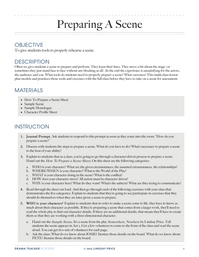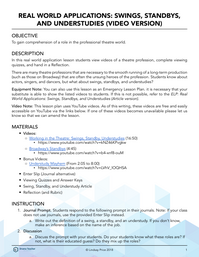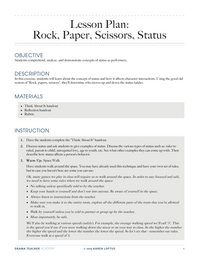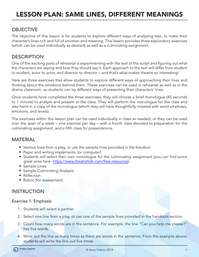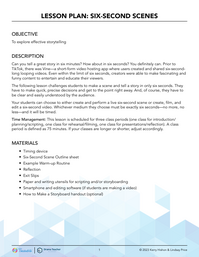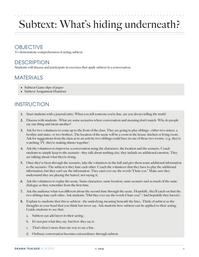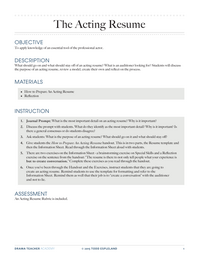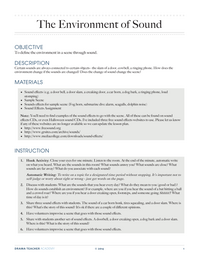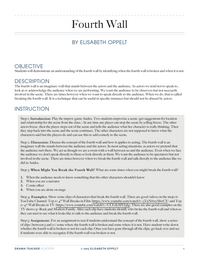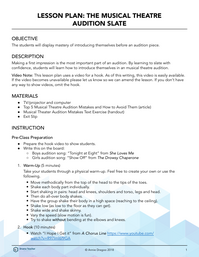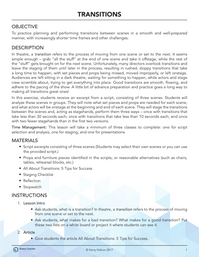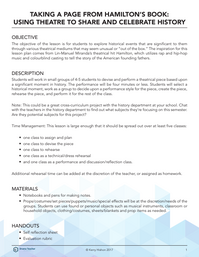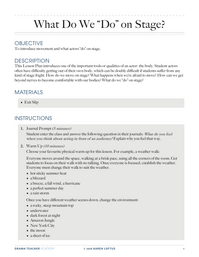Acting
209 Lesson Plans to help you effectively plan your workshops and classes
A Cross-Curricular Performance Challenge
by Kerry Hishon
Abstract Scene Performances
by Annie Dragoo
Accept the Offer
by Karen Loftus
Acting Techniques: A Method Exercise
by Lindsay Price
Acting the Monologue: Sugar and Salt
by Lindsay Price
Acting the Other and Intensifying the Tactics
by John Minigan
Acting the Song - Musical Tactics
by Anna Porter
Acting the Song - Textual Analysis
by Anna Porter
Acting vs. Performing a Song
by Annie Dragoo
After the Audition
by Lindsay Price
An Organic Approach to Objective, Obstacle, Action/Tactic
by Rachel Atkins
Analyzing Monologues
by Matthew Banaszynski
Analyzing the Play and Given Circumstances
by Drama Teacher Academy
Analyzing the Play and Given Circumstances
by Drama Teacher Academy
Appetite
by Todd Espeland
Applying Analysis to Performance
by Karen Loftus
Articulation
by Karen Loftus
Articulation
by Anna Porter
Audition Etiquette
by Lindsay Price
Beats and Action Words
by Lindsay Price
Becoming a Professional Actor: Getting Started
by Lindsay Price
Becoming a Professional Actor: Headshots
by Lindsay Price
Becoming a Professional Actor: Headshots
by Lindsay Price
Blocking Brainstorm
by Lindsay Price
Body Language
by Anna Porter
Brainstorming for an Autobiographical Monologue
by Gai Jones
British Panto Project
by Lea Marshall
Can You Hear Me Now? A Peer-Led Volume Exercise
by Kerry Hishon
Character History
by Annie Dragoo
Character Personality
by Todd Espeland
Character Physicalization, Part 1
by Lindsay Price
Character Physicalization, Part 2
by Lindsay Price
Character Walks
by Todd Espeland
Character Walks: Part Two
by Todd Espeland
Character Zero
by Allison Williams
Characters in a Scene
by Karen Loftus
Choosing a Monologue
by Lindsay Price
Comic and Serious Perspectives
by Gai Jones
Commedia Characters
by Todd Espeland
Commercials
by Ruthie Tutterow
Commercials
by Ruthie Tutterow
Contentless Scene - Preview Day
by Anna Porter
Defining Pantomime
by Angel Borths
Details of Pantomime
by Angel Borths
Differences Between Stage Acting and Film Acting & Vocabulary
by Ruthie Tutterow
Differences Between Stage Acting and Film Acting & Vocabulary
by Ruthie Tutterow
Drafting a Monologue
by Matthew Banaszynski
Eight-Line Power Plays
by John Minigan
Enriching Your Choices
by Annie Dragoo
Environmental and Personal Conflict
by Anna Porter
Exaggeration
by Anna Porter
Examining the Pause
by Lindsay Price
Exercises in Acting for the Camera
by Ruthie Tutterow
Exercises in Acting for the Camera
by Ruthie Tutterow
Exploring Principles of The Method
by Drama Teacher Academy
Exploring Principles of The Method
by Drama Teacher Academy
Exploring Spoken Word Poetry
by Kerry Hishon
Exploring the Architecture of the Mask
by Allison Williams
Final Assignment
by Todd Espeland
Final Performance
by Anna Porter
Final Project
by Anna Porter
Final Project
by Allison Williams
Final Rehearsal
by Lindsay Price
Finding Your Quality
by Ruthie Tutterow
Finding Your Quality
by Ruthie Tutterow
Gesture
by Karen Loftus
History of Commedia
by Todd Espeland
How to Practice Cold Reading
by Kerry Hishon
Improv for Character Study
by Annie Dragoo
Improv Using Sensory Awareness
by Annie Dragoo
Improv with Movement
by Annie Dragoo
Improv with Vocal Responses
by Annie Dragoo
Improvisation Scenes
by Annie Dragoo
Improvised Arguments
by Rachel Atkins
Inflection in Naked Scenes
by Marisa Peck
Initial Blocking
by Lindsay Price
Intention/Invention
by Todd Espeland
Intro to Improv for Musical Theatre
by Annie Dragoo
Introduction
by Karen Loftus
Introduction
by Anna Porter
Introduction and the Running Man
by Allison Williams
Introduction and Warm-Up Exercises
by Gai Jones
Introduction to Dance
by Anna Porter
Introduction to Monologue Writing
by Matthew Banaszynski
Introduction to Pantomime
by Anna Porter
Introduction to the Audition Process
by Lindsay Price
Ira Aldridge: Changing The Story
by Drama Teacher Academy
Lazzi
by Todd Espeland
Make Choices/Bring Information
by Karen Loftus
Make Your Partner Look Good
by Karen Loftus
Mask and Countermask
by Allison Williams
Mask Scenes
by Allison Williams
Memorization Techniques
by Lindsay Price
Mid-Unit Assignment
by Todd Espeland
Monologue Prep: Audition Set-Up
by Lindsay Price
Monologue Prep: Character Profile
by Lindsay Price
Monologue Prep: Vocal Profile
by Lindsay Price
Monologue Prep: Vocal Profile, Slate, and Thank You
by Lindsay Price
Monologue Writing
by Matthew Banaszynski
Monologue Writing: Character Specific Voice
by Lindsay Price
Monologue Writing: The Need to Speak
by Lindsay Price
More Minds Are Better Than One
by Matthew Banaszynski
Objectives and Tactics
by Annie Dragoo
Objects and Consistency
by Anna Porter
Onstage Action
by Karen Loftus
Pantomime Story and Performance
by Anna Porter
Peer Review Rehearsal
by Annie Dragoo
Performance and Evaluation
by Drama Teacher Academy
Performance and Evaluation
by Drama Teacher Academy
Performing a Monologue
by Matthew Banaszynski
Persuasive Actions & Objectives
by Rachel Atkins
Persuasive Actions With Vocal Expression
by Rachel Atkins
Play in a Week
by Steven Stack
Posture and Characterization
by Anna Porter
Power Plays in Three Statues
by John Minigan
Practical Uses of the Alexander Technique
by Ruthie Tutterow
Preparing a Scene
by Lindsay Price
Project: Performing Monologues
by Matt Webster
Purposeful Action
by Lindsay Price
Real World Applications: Swings, Standbys, and Understudies
by Lindsay Price
Rehearsal
by Lindsay Price
Rehearsal and Movement Practice
by Annie Dragoo
Rehearsals
by Drama Teacher Academy
Rehearsals
by Drama Teacher Academy
Relax, Have Fun and Don’t Force the Humour
by Karen Loftus
Removing Actor-Driven Movement
by Lindsay Price
Rock Paper Scissors Status
by Karen Loftus
Same Lines, Different Meanings
by Kerry Hishon
Scores and Beats
by John Minigan
Scoring the Script and Actions
by Drama Teacher Academy
Scoring the Script and Actions
by Drama Teacher Academy
Script Analysis: Close Reading
by Lindsay Price
Script Analysis: Scoring
by Lindsay Price
Script Analysis: The Basics
by Lindsay Price
Show and Tell Characterization
by Anna Porter
Six-Second Scenes
by Kerry Hishon
Stage Business
by Anna Porter
Stage Directions
by Karen Loftus
Stage Pictures
by Lindsay Price
Stanislavski and "The Method"
by Drama Teacher Academy
Stanislavski and "The Method"
by Drama Teacher Academy
Status
by Todd Espeland
Status and Swing in Character
by Todd Espeland
Status Games
by Todd Espeland
Stock Character Walks
by Karen Loftus
Subtext: What’s hiding underneath?
by Lindsay Price
Swing
by Todd Espeland
Take the Active Choice
by Karen Loftus
The Acting Resume
by Todd Espeland
The Acting Resume
by Todd Espeland
The Actor and the Stage
by Annie Dragoo
The Actor's Voice
by Annie Dragoo
The Audition Slate
by Annie Dragoo
The Beats in Every Scene
by John Minigan
The Criteria of a Good Monologue
by Lindsay Price
The Environment of Sound
by Lindsay Price
The Fourth Wall
by Elisabeth Oppelt
The Mock Audition
by Lindsay Price
The Musical Theatre Audition Slate
by Annie Dragoo
The Power of Relaxation
by Ruthie Tutterow
The Qualities of Movement
by Allison Williams
The Scene
by Annie Dragoo
The Specifics of Holding an Object
by Karen Loftus
The Stanislavski Method
by Karen Loftus
The Story Mountain Framework
by Matthew Banaszynski
The Technicalities of Stage Movement
by Karen Loftus
Thou Shalts of Staging and Performance
by Anna Porter
Transitions
by Kerry Hishon
Unit Project
by Karen Loftus
Unit Project
by Karen Loftus
Unit Project
by Karen Loftus
Unit Project
by Karen Loftus
Unit Project
by Karen Loftus
Unit Reflection (Essay)
by Annie Dragoo
Using Emotional Recall
by Annie Dragoo
Using Movement to Convey an Idea
by Annie Dragoo
Using Theatre to Share and Celebrate History
by Kerry Hishon
Vocal Variety
by Anna Porter
What Do We “Do” on Stage?
by Karen Loftus
What is Abstract Theatre?
by Annie Dragoo
What is the Alexander Technique?
by Ruthie Tutterow
What makes a “good voice?”
by Karen Loftus
